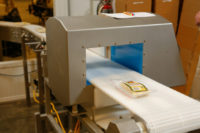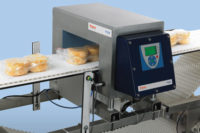

But perhaps these qualities are even more important in detection equipment that in many cases is the last line of quality defense between the plant floor and the store shelf. We reached out to several suppliers of X-ray and metal detection equipment, and here’s what they told us. Responses have been edited for space:
DFR: What are dairy processors demanding right now from their X-ray and metal detection equipment?
Ray Spurgeon Jr., product manager-inspection systems, Eriez Manufacturing Co., Erie, Pa.: Dairy processors demand that inspection system manufacturers follow strict guidelines for construction and performance. The system must also withstand rigorous washdown. The systems must be easily disassembled for cleaning. Additionally, inspection systems must be easy to operate, do what they are intended to do, have data collection capability, not disrupt production with false detection and capable of networking with mainframes.
Steve Mason, national sales manager, Fortress Technology Inc., Toronto: Dairy processors are looking for metal detection equipment that is both easy to use and provides a high level of sensitivity. In addition, they want reliable units that do not break down or require continual maintenance procedures.
Kevin Jesch, product manager, inspection systems, Heat and Control Inc., Hayward, Calif.: Processors are calling for increased sensitivity for their inspection equipment. Products such as cheese make metal detection difficult because of the large product effect signal produced by the salt and moisture these products contain. Since X-ray works on density contrast, the product effect signal is not a factor. In general, X-ray can detect smaller contaminants than metal detection. On the other hand, the CEIA THS 21 series multispectrum metal detectors offer enhanced electronic filtering of the product effect. The Ishida IX-GA X-ray series can be configured to provide the best sensitivity for a specific contaminant such as glass.
Allan Anderson, president, InspX, Fremont, Calif.: Many inquiries we get from dairy processors arise when they change their packaging to incorporate a metal foil seal on a package. The presence of the foil frustrates the use of a metal detector that may have been part of their HACCP program, and they must develop an alternative approach. Then the customer asks about his most common source of contamination, that of broken O-rings. The InspX ScanTrac Solo side-view X-ray inspection system detects plastics in many forms that are used for O-rings. With the side-view look, the Solo also makes an accurate fill-level measurement, so the customer comes away with two inspections that they really want (O-ring and fill) and a way to meet the needs of one that they have to have (metal detection).
Martin Lymn, general manager, sales and service, Loma Systems (an ITW Company), Chicago: A continued emphasis on consistent and dependable performance with rapid recovery in the event of downtime. With an ever-increasing focus on food safety, maintaining a foreign-body detection capability is paramount.
DFR: What is the top concern among your customers?
Spurgeon: Performance is most often cited as number one. Secondly, reliability and repeatability are a must; the unit has to meet the claims made. Also, service and support round out the top concerns; a well-supported system must have 24/7 support with immediate online assistance.
Jesch: For products with a strong product effect, false rejects can be a big problem for processors. The CEIA THS 21 multispectrum metal detector effectively reduces the product effect significantly, so that best sensitivity can be maintained. Different products or product with different characteristics (frozen and thawed) can be autolearned in the same setup operation to allow a range of products to run under one machine setting.
Anderson: Since X-ray is new, most customers want to have assurance about the technology, the product and the company. Since we have been supplying X-ray systems for a relatively long time, our customer references serve us well in overcoming the traditional reluctance to be the first at anything.
DFR: What changes in food safety practices have impacted your business?
Jesch: As sanitation requirements become more and more stringent, the washdown rating of our equipment becomes more important. Both the CEIA metal detectors and the Ishida X-ray units that we offer include an option for IP69K washdown rating. This requires resistance to water sprayed at high pressure and high temperature at close range.
Lymn: The increased profile of microbiological contaminant control has had the side-effect of increasing the visibility of all elements of a food safety program. This and greater traceability demands have driven greater interest in simple networking of metal detectors and X-ray so that records that they were in use and meeting required levels of detection capability are always available.
DFR: How are you meeting your customers’ demands?
Spurgeon: We first have to explain to our prospects the technology’s capabilities and limitations. Accordingly, manufacturers such as Eriez offer Web presentations and plant visits to help them gain a better grasp of how the technology works. We also offer product testing at no charge. It is also advantageous to have your manufacturer come in to conduct a plant survey. To make the best recommendations possible, your manufacturer must understand the full scope of the application.
Mason: Fortress manufactures metal detection equipment that is easy to use, reliable and provides high sensitivity without false rejects. In addition, Fortress Contact data collection software provides our customers with the ability to automatically collect information from the detectors and organize that information into relevant comprehensive customized reports.
Jesch: Requirements for traceability and documentation are increasing. CEIA THS 21 series metal detectors are in compliance with FDA requirements for FDA Title 21 Part 11. This includes features such as reject confirmation, user-definable testing intervals and fully controllable user access for traceability. Events are stored in memory for reporting purposes. Ishida X-ray offers Ethernet connectivity and can be used to track inspection events in real time. CEIA metal detectors also offer Ethernet, as well as a ready-to-go package of production software.
Anderson: One of our new systems is the ScanTrac Crescendo that features two X-rays scanning from bottom to top and top to bottom, both from the side. This provides a precise inspection of large cheese blocks up to 12 inches high and 8 inches wide, and a variable length. Our customers’ demands for prompt, efficient and cost-effective service dictated that all of our systems connect over the Internet and include a host of on-board diagnostics and tools.
DFR: What’s next for X-ray and metal detection technology?
Spurgeon: We have introduced zone detection for our X-ray technology, which means that individual zones or packages can be scanned for precise rejection of foreign objects. This feature will save our customers thousands in rework and material costs. We now offer live online X-ray product testing. This will allow customers to look at their products running live through a machine from their location anywhere in the world. We are working with plastic manufacturers that produce items used in the production of food and have developed an additive to make these items X-ray detectable.
Mason: Improved detection levels on dairy products, making it easier to collect data wirelessly, as well as reducing the overall cost of ownership are just a few of the initiatives on the horizon.
Lymn: Variable frequency, the Holy Grail for metal detection, is already here. The next technological barrier to be broken is not clear in metal detection; logical continued improvements in how product signals are handled, however, will be of particular interest to our cheese industry customers in particular. In X-ray, development continues at a remarkable pace, yielding improvements on contaminant resolution, line speeds, application types and ease of use.
Extras
Eriez Manufacturing Co. www.eriez.com
Fortress Technology Inc. www.fortresstechnology.com
Heat and Control Inc. www.heatandcontrol.com
InspX www.InspX.com
Loma Systems www.loma.com

